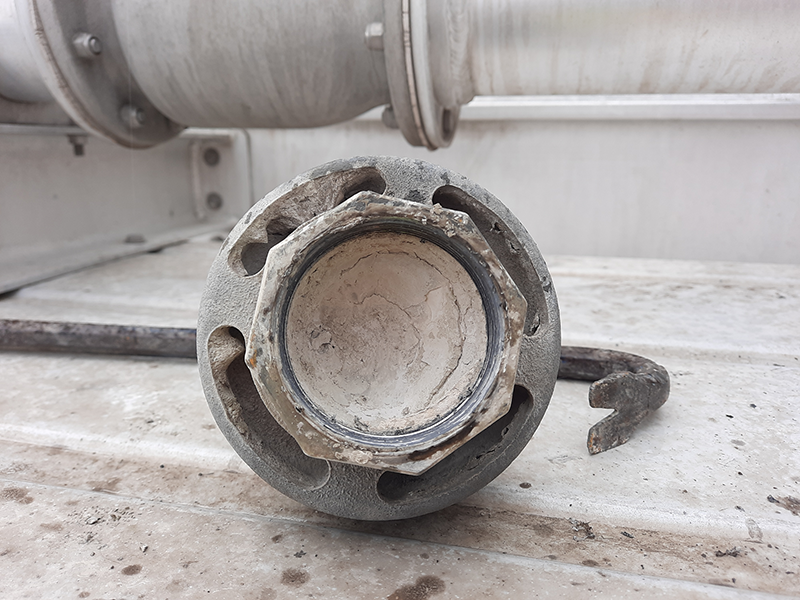Alert: Dry bulk (cement) container explosion hazard
Employers can prevent explosion hazards to workers by following manufacturer’s instructions and maintaining dry bulk containers and equipment in good condition.
Hazard summary
When tanker trucks are used to deliver dry Portland cement to a facility silo, air is used to push the product from the truck through pipes and hoses.
The tank may catastrophically rupture if the air pressure inside the tank is not kept below the maximum pressure of the tank. The air compressor of the truck must be properly regulated and pressure relief valves on the tanker must be maintained in good condition, functioning properly and kept free from the buildup of cement.
Hazard example
One tank explosion caused the rear wheels of the truck to shift approximately 1 metre opposite to the direction of blast discharge, and a man door of a building located 14 metres from the tanker was blown open.

Figure 1: Pressure relief valve for tanker plugged with cement-like material
Key legal requirements
Under the Occupational Health and Safety Act, employers have general duties, including the duty to take every precaution reasonable in the circumstances to protect the health and safety of workers.
Employers must make sure equipment is maintained in good condition.
Another key duty for employers is to provide information, instruction, and supervision to protect the health and safety of workers.
Safety precautions
Employers must ensure cement pump trucks and dry bulk containers are:
- maintained in good condition and don’t endanger a worker
- used in accordance with the manufacturer’s operating manual
- not used while they are defective or hazardous
Dry bulk container manufacturers generally have detailed procedures for the loading and unloading of the containers to ensure they are operated in a manner that maintains the equipment in good condition and ensures the safety of workers. Employers must ensure their workers are trained in, and follow, these procedures.
Employers should ensure pressure relief valves are regularly examined and cleaned. The regulator of the air compressor should also be regularly examined to ensure proper functioning.
No modification to, extension to, repair to, or replacement of a part of, a cement pump truck or dry bulk container shall result in a reduction of the safety factor of the equipment.
No worker shall operate a dry bulk cement pump truck unless he or she is competent to do so. However, a worker being trained in the operation of a cement pump truck may operate it while being instructed and supervised by a competent person.
Ontario Regulation 213/91 – Construction Projects sets out general requirements regarding equipment used on construction projects, in sections 93-96. Following those requirements in an industrial establishment could serve as reasonable precautions in these circumstances.
Owners of cement pump trucks and dry bulk containers should:
- register their equipment with the manufacturer or authorized distributor dealer to receive any service updates, recalls or advisories
- ensure a competent worker completes the service bulletin, advisory and maintenance updates that the manufacturer recommends
- not add modifications or additional parts except in accordance with the manufacturer’s specifications
Contact us
If you need more information about safety requirements, please contact the Ministry of Labour, Immigration, Training and Skills Development Health & Safety Contact Centre at
This resource does not replace the Occupational Health and Safety Act (OHSA) and its regulations and should not be used as or considered legal advice. Health and safety inspectors apply and enforce these laws based on the facts they find in the workplace.